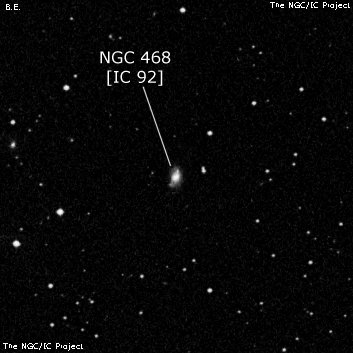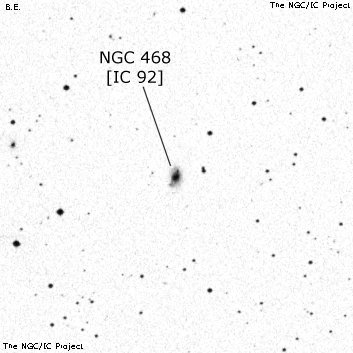NGC/IC Project Restoration Effort
(This is a very very beta version)
NGC468


Basic Information
Location and Magnitude
Right Ascension: 1:19:48.4
Declination: +32:46:2
Constellation: PSC
Visual Magnitude: 14.3
Historic Information
Discoverer: Herschel J.
Year of discovery: 1827
Discovery aperture: 18.3
Observational
Summary description: vF, eS, stellar
Sub-type: S0-a
Corwin's Notes
=====
NGC 468 is not IC 92, as I have long supposed. Courtney Seligman wrote in
March 2015 suggesting that the NGC object might be identical with NGC 472, a
brighter galaxy than IC 92, and at the same declination.
After looking at JH's Sweeps for a day, I wrote back to Courtney, "The short
answer is that you're right: NGC 468 is almost certainly a second observation
of NGC 472."
Here is a somewhat condensed version of the longer answer:
At first, I was as puzzled as you were by the fact that JH had apparently
swept up a fainter galaxy instead of a brighter one. But this is indeed
possible because of the way that both Herschels swept the sky -- they used
their telescopes as meridian instruments, "sweeping" north and south in
short arcs of typically 2.5 to 3 degrees, while the diurnal motion carried
the sky westward across the meridian through their field of view. It's
possible to miss objects if the north-south arcs are too long and the
diurnal motion carries the sky too far west. I thought that this might have
happened here. Wolfgang Steinicke has found cases in William Herschel's
sweeps where it actually accounts for missing nebulae.
With this kind of sweeping, errors in RA are just as likely as those in Dec.
Indeed, in both the Herschels' observations, there are many RA errors of not
just digits (e.g. 1 minute, 10 minutes, etc), but of seemingly odd amounts
like 18 seconds, 46 seconds, and other strange numbers. That's the case
here where, as Courtney noted, the Dec is correct for N472, but the RA is
off by 37 seconds.
This inspired me to dig into JH's Sweep 106 on 22 November 1827. I did a
rough "reduction" of his observation w.r.t. one of the stars in the sweep,
sigma Trianguli. That got me to within a few arcminutes of the position in
the NGC, but not close enough to really verify JH's position. So, I had to
ask how he did his reductions, a question that I've been curious about, but
never had to answer before. (JH, by the way, describes his reduction
technique in detail in one of his early papers on double stars. This paper,
unfortunately, does not seem to be currently on-line.)
After reading through many of his early sweeps -- which are preserved in a
"fair copy" up to Sweep 107 so they are more legible than the actual
observing logs -- I worked out what the entries in the logbooks mean. Here
is the observation of NGC 468:
01 12 45 -29 2 01 10 00
The first three numbers are a clock or watch reading, the 4th is a count on
a chronometer ticking off 130 (*not* 120) "beats" per minute, the fifth is
the eyepiece wire -- there were two of them (though JH also occasionally
used the trailing edge of the eyepiece field as a third "wire") with which
he timed the meridian passage, and the last three numbers are the NPD
"index" on a scale marked in degrees, minutes, and seconds of arc.
To reduce the RA, JH applies various corrections to these measurements, the
main ones being the clock correction for each wire, along with the
difference between the transit and the count of the chronometer "beat."
(All this, incidentally, must have been recorded by JH's assistant, usually
John Stone, finally mentioned by name in the Cape of Good Hope Observations,
so that JH would not have had to ruin his night vision.) The clock
corrections, as well as the index zero points are worked out by using known
star positions, of course. For this sweep, JH has clock corrections of
-1m 37.0s for wire 1, -2m 13.5s for wire 2, and -2m 45.9s for the trailing
edge of the field. Applying the number for wire 2, along with 13.4 seconds
for the 29 chronometer "beats" to the 01 12 45 clock reading gives an RA of
01 10 18.1 for the date of observation (in this case, JH simply took 1828,
close enough given his usual accuracy).
Similarly, the mean NPD zero point is +57d 02' 36" for the sweep, so the NPD
is 58 12 36, again for epoch 1828. JH then precessed this to 1830 with his
precession tables (which I haven't uncovered yet), but using the modern
precession, these come close to the numbers that JH included on his
reduction pages, that he copied into his published papers, and that Dreyer
eventually copied into the NGC.
Going through the reduction again shows that there is no large error in JH's
calculations or the resulting positions, in either RA or NPD.
But, looking at the log, I noticed that the "2" notation for the wire number
appears to have a "1" written over it. It's not very clear, and could well
be the result of the photocopying process as the RAS people were copying the
page for the Herschel Archive. But the "-29" has a similarly overstruck
"2", so I wondered what would happen if the wire number actually was "1" and
not "2". Going through that reduction gave me the RA as 01 10 54.6, with the
same NPD, 58 12 36, for 1828. This becomes 01 20 30.2, +32 41 45 for J2000.
Compare this with the modern value of 01 20 28.7, +32 42 33 from UCAC for
NGC 472 -- there it is.
So, it looks to me like the wrong wire was recorded in the Sweep. If this is
the only mistake, it seems reasonable to simply adopt JH's published position
and correct it by the +36.5 seconds of time between the first and second wires
at the same declination. The agreement in position between the two
observations is even closer with this easy fix.
All this makes additional sense if JH actually saw the brighter NGC 472 rather
than the fainter IC 92. We can't be absolutely sure that this is the correct
explanation, of course, but this looks like another kind of "digit error" that
could happen fairly commonly. I will re-examine other of JH's apparent RA
errors to see if the same reasoning can recover other "lost" or misidentified
objects that he observed. (A couple of additional cases of possibly mistaken
wires are the clusters NGC 6396 and NGC 6400, both of which see. Their
identifications are not in doubt, but the RA's are off.)
Steve's Notes
=====
NGC 468
See observing notes for NGC 472.



